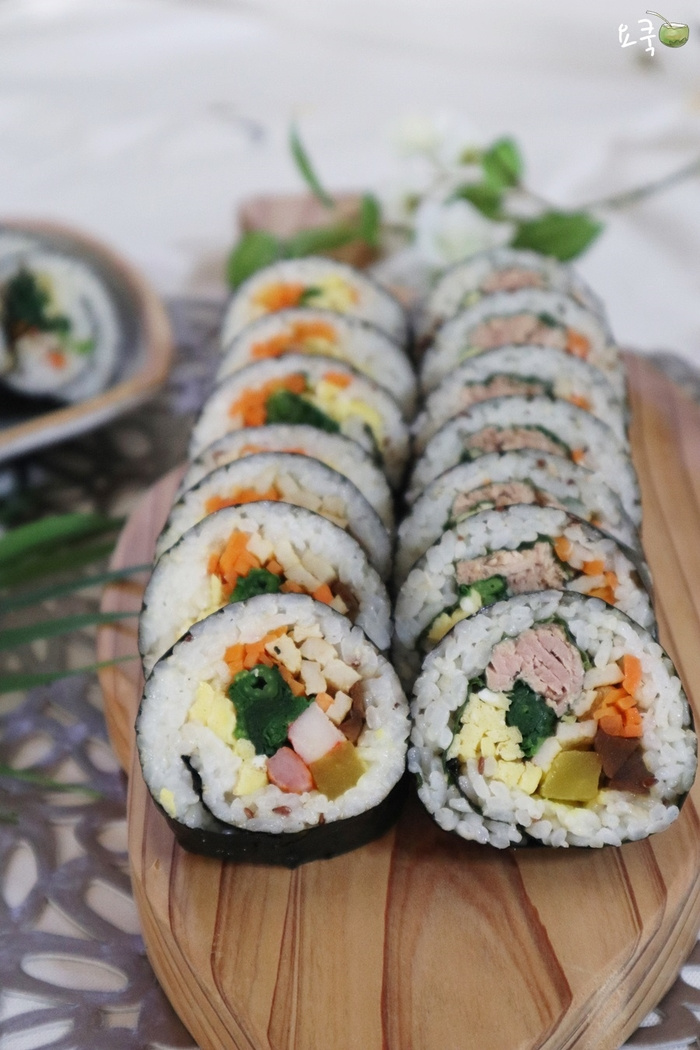Rich & Creamy Tuna Mayo and Anchovy Kimbap
A Delicious Recipe for Tuna Mayo Kimbap, Enhanced with Savory Anchovy Kimbap

Introducing ‘Tuna Mayo Anchovy Kimbap’, a satisfying meal perfect for the whole family or a delightful snack when hunger strikes. This kimbap recipe is ideal for making with kids during school breaks, and it’s also wonderful to make in large batches to share with neighbors. Rolling various ingredients together creates a tasty snack that kids can easily grab and enjoy anytime. Since I had some stir-fried anchovies on hand, I decided to make anchovy kimbap as well for an extra layer of savory flavor. With plenty of tuna and fresh vegetables rolled into the tuna mayo kimbap, it makes a wonderful meal even without any side dishes. Highly recommended for kids’ snacks and lunchboxes!
Kimbap Ingredients- Cooked rice
- Roasted seaweed sheets (for kimbap)
- Canned tuna (drained)
- Carrot
- Pickled radish (danmuji)
- Ham
- Imitation crab sticks (mat-sal)
- Spinach
- Square fish cakes
- Perilla leaves (kkaennip)
- Eggs
- Stir-fried anchovies
- Toasted sesame seeds
- Salt (a pinch)
- Sesame oil
- Mayonnaise
Cooking Instructions
Step 1
Prepare fresh spinach. Trim the root ends carefully, making sure not to discard the reddish part, and rinse them thoroughly in rice water. Bring a pot of water to a rolling boil with a pinch of coarse salt. Blanch the spinach for about 10 seconds – just long enough to wilt slightly. Immediately remove it to preserve its crisp texture and vibrant flavor.

Step 2
Rinse the blanched spinach under cold running water to stop the cooking process. Squeeze out as much excess water as possible. Properly draining the spinach prevents the kimbap from becoming soggy.

Step 3
Wash the carrot thoroughly and julienne it into thin strips. Try to cut all the kimbap filling ingredients into similar thicknesses for a harmonious eating experience.

Step 4
Heat a lightly oiled pan. Add the julienned carrots and a pinch of coarse salt. Stir-fry briefly until the carrots are slightly tender but still have a slight bite. Avoid overcooking them.

Step 5
Whisk the eggs to break the yolks and remove any stringy bits. Cook them into thin omelets or egg crepes, then let them cool and julienne them finely. You can make thicker omelets and cut them into wider strips if you prefer, but I find that finely julienned carrots and egg crepes create a softer, more integrated texture within the kimbap.

Step 6
Julienne the square fish cakes into thin strips. Place them in a dry (no oil) pan and pan-fry them until lightly golden brown on both sides. This enhances their chewy texture and adds a savory depth.

Step 7
Pan-fry the ham slices until they are golden brown on both sides. Once cooked, slice them into manageable pieces for the kimbap. Lightly frying the ham makes it even more flavorful and aromatic.

Step 8
Double-check the julienned fish cakes. Cut them in half lengthwise to better fit the kimbap roll, then pan-fry them in a dry pan until golden brown on both sides. This step is crucial for achieving the best texture for the fish cakes in the kimbap.

Step 9
Carefully drain all the oil from the canned tuna. You can use the can lid or a fork to press down firmly on the tuna to extract as much oil as possible. Excessive oil can make the kimbap greasy.

Step 10
Wash the perilla leaves and pat them dry. Ensure that the pickled radish (danmuji) and burdock root (if using) are also well-drained. Having all your filling ingredients prepped and ready makes the rolling process much smoother.

Step 11
Season freshly cooked hot rice with a pinch of salt, sesame oil, and toasted sesame seeds. Mix gently until well combined. Since the filling ingredients are seasoned individually, keep the seasoning of the rice moderate to balance the overall flavor. Be careful not to mash the rice grains.

Step 12
Place a sheet of roasted seaweed on a bamboo rolling mat, shiny side down. Spread a thin, even layer of the seasoned rice over the seaweed, leaving about a 1cm border along the top edge. Arrange your prepared fillings neatly over the rice. Squeeze a zigzag pattern of mayonnaise over the perilla leaves, then generously top with the drained tuna. Using the bamboo mat, roll the kimbap up tightly.

Step 13
When slicing the kimbap, a serrated bread knife works best for clean cuts. Slice the kimbap into even pieces, being careful not to press too hard and crush the roll. If you don’t have a bread knife, use a sharp knife and a gentle sawing motion.

Step 14
For anchovy kimbap, use the stir-fried anchovies instead of tuna. Spread a little mayonnaise on the perilla leaves, then add a generous amount of stir-fried anchovies before rolling. The anchovies, often stir-fried with nuts, add a wonderful nutty flavor and satisfying crunch, making this anchovy kimbap quite special.




